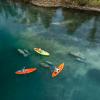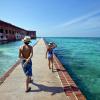A Guide to the Birds Along Florida's Shores and Beaches
Beaches and birds: they're a natural pairing. But what kinds of birds are those creatures squawking, soaring and diving along the beaches and shorelines of the Sunshine State? Learn to discern your terns from your gulls with this helpful beach bird guide:
Gulls
Graceful and acrobatic, gulls are hardly cautious around humans. They will not hesitate to swoop down and take a potato chip right out of your hand.
Laughing gulls, so named because their call sounds like a laugh, are easily identified by their black head and red bill. Herring gulls are much larger, with a white head. The small ring-billed gull has a black ring around its yellow bill. They all tend to intermingle.
Enjoy watching gulls, but please don't feed them. Yes, it's fun, but it makes them aggressive and dependent on humans for food.
Terns
Terns look a lot like gulls – gray above, white below – but they are a separate species. They have a lighter, more buoyant flight with sleeker, narrower bodies and wings, forked tails and very sharp beaks. Terns will hover briefly over the water, 10 to 30 feet in the air, and then dive gracefully to catch a fish.
The largest terns are the Royal tern, with an orange bill, and the Caspian tern, with a blood-red bill. The smallest tern is named, appropriately, the Least tern. It has a yellow bill, black cap and white forehead. In between is the Forster's tern, which dons a black cap and orange-red bill.
Sanderlings, Dowitchers and Willets
Sanderlings, dowitchers and willets are shorebirds. Find them on the beach near the water's edge, looking for food by probing the wet sand with their bills. When humans approach, shorebirds will often run away rather than take flight.
At slightly more than six inches in length, one of the smallest Florida shorebirds is the sanderling. A black bill, jet black eyes and speedy black legs give them away. You'll see them, usually in groups of a dozen or fewer, scurrying on tiny legs ahead of surging waves.
Dowitchers also frequent the shoreline, but are larger and run less than sanderlings. They have a long, thin bill and are usually gray or light brown in color, depending on the time of year. You’ll see them in flocks of 100 or more at times.
One of the larger Florida shorebirds is the willet. With a relatively long bill, long legs and gray body, a willet is fairly easy to pick out, especially when mingling with sanderlings and dowitchers. You’ll see willets in small flocks, alone or in pairs.
Herons and Egrets
These long-legged wonders are my favorites. Herons and egrets gather near water anywhere in Florida. Here are some of the most common species:
White herons and egrets
- Snowy egret – White with black legs and bright yellow feet.
- Great egret – White with yellow bill, black legs and feet.
Grey or blue herons
- Great blue heron – Large, blue-gray heron, mostly white head, yellow bill. Solitary.
- Little blue heron – Small, bluish heron with reddish neck and head. Blue bill with black tip.
- Tricolored heron – Blue-gray heron with white underparts and light-colored throat.
Other Florida Beach Birds
- Roseate spoonbill – Bright pink, long-legged wading bird with a spoon-shaped bill.
- Ibis – The white ibis has a white and red face with a curved, red bill.
- Black skimmer – Jet black above, white below. Lower bill extends farther than upper bill. Flies over shallow water “skimming” its lower bill in the water until it snatches a fish. Very active at sunset along the beach.
- Oystercatcher – Small shorebird usually seen alone or in pairs. Black on top, white underneath, with long reddish-orange bill.
- Brown pelican – This brown-feathered bird is easy to approach, especially on a fishing pier. Their large bill has a pouch to help them hold fish. You may spot a white pelican in Florida in the winter. Unlike the brown variety, white pelicans do not dive for fish.
Birds Nesting on the Beach
Many terns and other Florida shorebirds lay their eggs in the sand. The eggs are hard to see and must be constantly guarded, or a hungry predator will eat them. The eggs must also be shaded by an adult or the sun may overheat them.
When you see signs warning that you are in a bird nesting area on the beach, be sure to stay clear, even if you don't see any birds at that moment.
Litter and Birds
Litter can be deadly to birds and other wildlife. Fishermen should properly dispose of their used fishing line. Birds can get their feet tangled in a piece of monofilament line.
Other plastic items with holes can also become traps, so please dispose of all trash properly and help keep our birds healthy.
Injured Birds
If you encounter a bird that appears to be injured, do not try to rescue it yourself. Contact the local beach patrol, lifeguard, park rangers or other authorities. They can contact local bird rescue volunteers, who are trained to capture and transport injured or sick seabirds. (Do not dial 911.)
If you see baby seabirds on the beach that seem to be abandoned, do not approach them. They may not be abandoned at all. Your presence may prevent the parent birds from returning with food. If in doubt, alert the authorities mentioned above.
If you hook a bird while fishing, very gently reel in the bird. Do not just cut the line. Cover the bird's eyes with a light towel, cloth or shirt to help calm the bird, then gently remove the hook. You may need to push the point through the skin and cut off the barb before you can extract the hook. Seek help if the bird seems to be in distress, but you can release it otherwise. Most fishing piers have posted instructions for dealing with hooked birds.
Where to Find Florida Beach Birds
You can find Florida’s beautiful seabirds on any beach or bay shoreline, or in and around mangrove trees, seawalls and piers. Mornings and evenings are particularly good times to watch birds, since they are most active during those times.
Many of Florida's shorebirds, egrets and herons are even active after dark and can be seen on the beach during a full moon. A great place to watch pelicans and herons is on any pier with fishermen.
In Florida, many of our seabirds are migratory and can be seen in greater abundance during fall and winter migration. A few places that are especially good for Florida beach birding:
- Gulf Islands National Seashore
- Honeymoon Island State Park
- Fort De Soto County Park
- Sanibel Island (J.N. “Ding” Darling National Wildlife Refuge)
- Fort Myers Beach (lagoon and mud flats by the Holiday Inn)
- Marco Island's Tigertail Beach
- Fort Clinch State Park
- Merritt Island National Wildlife Refuge
- Everglades National Park
You might also like to try the Great Florida Birding & Wildlife Trail, a 2,000-mile driving tour connecting 492 great birding hot spots.
PLACES TO REMEMBER
RELATED CONTENT
Great Hiking Trails in Florida
- 10 minute read
By Lauren Tjaden With varied terrain and tremendous ecological diversity, Florida provides hikers of every skill level a perfect backdrop for exercise...






























